IT Risk Management: Importance, Strategies, and Benefits
VerifiedAdded on 2021/06/16
|9
|2238
|33
Report
AI Summary
This report delves into the critical importance of IT risk management in today's technology-driven environment. It highlights the necessity of safeguarding sensitive organizational data and ensuring business continuity in the face of increasing cybersecurity threats. The report emphasizes the implementation of risk management tools, cryptographic techniques, and incident response procedures as essential components of a robust security framework. It explores the benefits of IT risk management, including the reduction of security breaches, data access control, and the mitigation of financial losses associated with security incidents. Furthermore, it underscores the significance of user authentication, monitoring user activities, and establishing a culture of security awareness within organizations. The report also discusses the role of risk tolerance, risk appetite, and the development of comprehensive strategies to combat security risks effectively, ultimately contributing to the overall resilience and success of organizations in the face of evolving cyber threats. It also highlights the role of training and staff awareness in preventing cyber attacks.
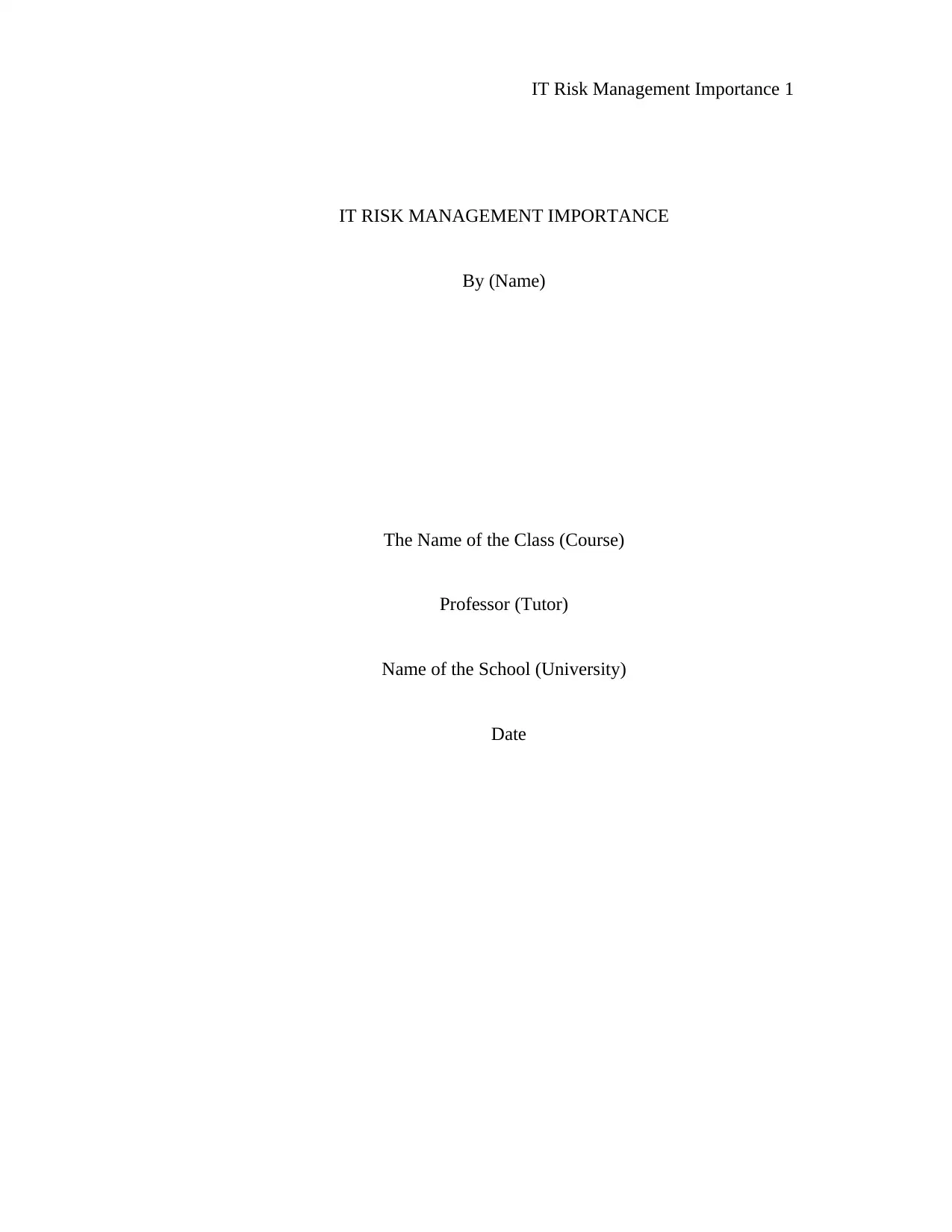
IT Risk Management Importance 1
IT RISK MANAGEMENT IMPORTANCE
By (Name)
The Name of the Class (Course)
Professor (Tutor)
Name of the School (University)
Date
IT RISK MANAGEMENT IMPORTANCE
By (Name)
The Name of the Class (Course)
Professor (Tutor)
Name of the School (University)
Date
Paraphrase This Document
Need a fresh take? Get an instant paraphrase of this document with our AI Paraphraser
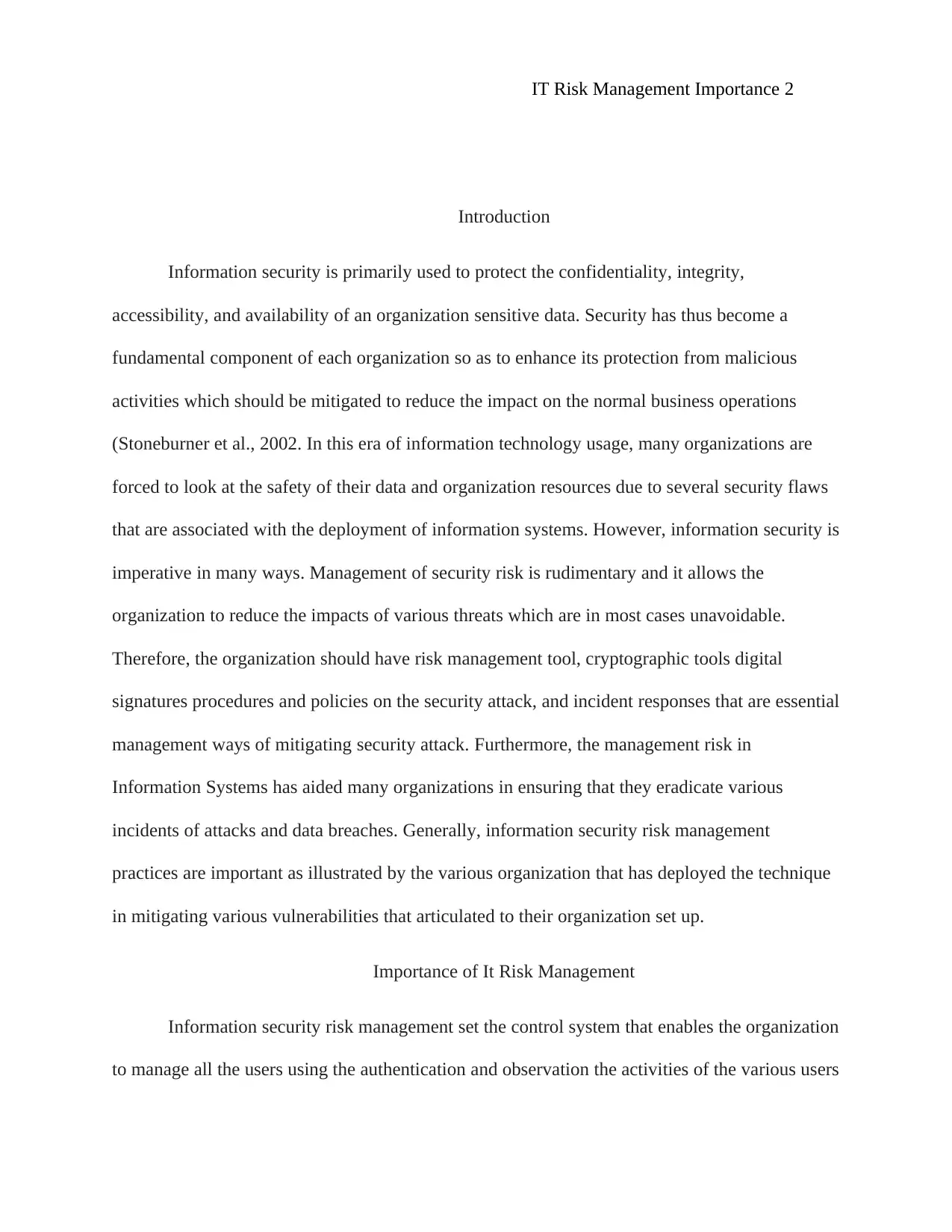
IT Risk Management Importance 2
Introduction
Information security is primarily used to protect the confidentiality, integrity,
accessibility, and availability of an organization sensitive data. Security has thus become a
fundamental component of each organization so as to enhance its protection from malicious
activities which should be mitigated to reduce the impact on the normal business operations
(Stoneburner et al., 2002. In this era of information technology usage, many organizations are
forced to look at the safety of their data and organization resources due to several security flaws
that are associated with the deployment of information systems. However, information security is
imperative in many ways. Management of security risk is rudimentary and it allows the
organization to reduce the impacts of various threats which are in most cases unavoidable.
Therefore, the organization should have risk management tool, cryptographic tools digital
signatures procedures and policies on the security attack, and incident responses that are essential
management ways of mitigating security attack. Furthermore, the management risk in
Information Systems has aided many organizations in ensuring that they eradicate various
incidents of attacks and data breaches. Generally, information security risk management
practices are important as illustrated by the various organization that has deployed the technique
in mitigating various vulnerabilities that articulated to their organization set up.
Importance of It Risk Management
Information security risk management set the control system that enables the organization
to manage all the users using the authentication and observation the activities of the various users
Introduction
Information security is primarily used to protect the confidentiality, integrity,
accessibility, and availability of an organization sensitive data. Security has thus become a
fundamental component of each organization so as to enhance its protection from malicious
activities which should be mitigated to reduce the impact on the normal business operations
(Stoneburner et al., 2002. In this era of information technology usage, many organizations are
forced to look at the safety of their data and organization resources due to several security flaws
that are associated with the deployment of information systems. However, information security is
imperative in many ways. Management of security risk is rudimentary and it allows the
organization to reduce the impacts of various threats which are in most cases unavoidable.
Therefore, the organization should have risk management tool, cryptographic tools digital
signatures procedures and policies on the security attack, and incident responses that are essential
management ways of mitigating security attack. Furthermore, the management risk in
Information Systems has aided many organizations in ensuring that they eradicate various
incidents of attacks and data breaches. Generally, information security risk management
practices are important as illustrated by the various organization that has deployed the technique
in mitigating various vulnerabilities that articulated to their organization set up.
Importance of It Risk Management
Information security risk management set the control system that enables the organization
to manage all the users using the authentication and observation the activities of the various users
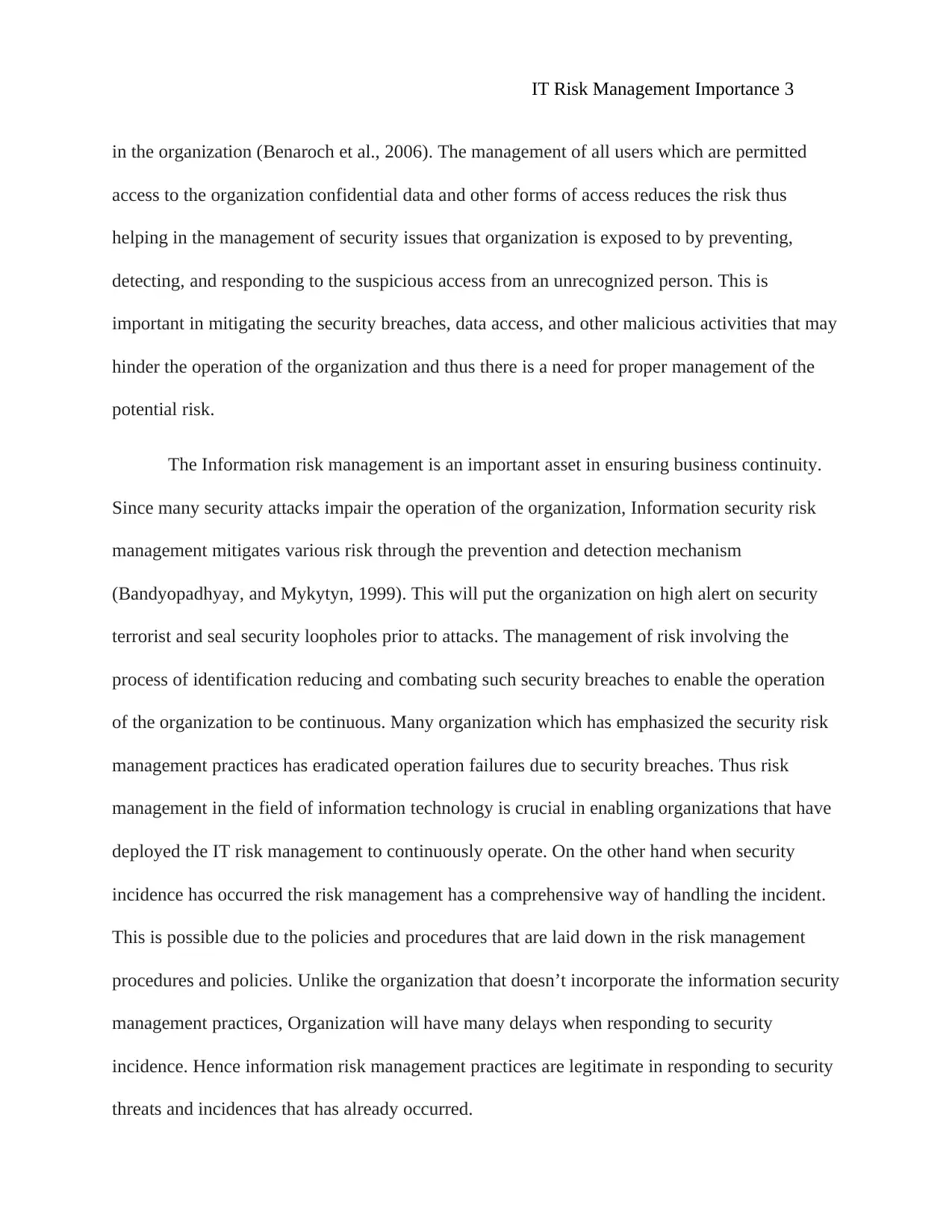
IT Risk Management Importance 3
in the organization (Benaroch et al., 2006). The management of all users which are permitted
access to the organization confidential data and other forms of access reduces the risk thus
helping in the management of security issues that organization is exposed to by preventing,
detecting, and responding to the suspicious access from an unrecognized person. This is
important in mitigating the security breaches, data access, and other malicious activities that may
hinder the operation of the organization and thus there is a need for proper management of the
potential risk.
The Information risk management is an important asset in ensuring business continuity.
Since many security attacks impair the operation of the organization, Information security risk
management mitigates various risk through the prevention and detection mechanism
(Bandyopadhyay, and Mykytyn, 1999). This will put the organization on high alert on security
terrorist and seal security loopholes prior to attacks. The management of risk involving the
process of identification reducing and combating such security breaches to enable the operation
of the organization to be continuous. Many organization which has emphasized the security risk
management practices has eradicated operation failures due to security breaches. Thus risk
management in the field of information technology is crucial in enabling organizations that have
deployed the IT risk management to continuously operate. On the other hand when security
incidence has occurred the risk management has a comprehensive way of handling the incident.
This is possible due to the policies and procedures that are laid down in the risk management
procedures and policies. Unlike the organization that doesn’t incorporate the information security
management practices, Organization will have many delays when responding to security
incidence. Hence information risk management practices are legitimate in responding to security
threats and incidences that has already occurred.
in the organization (Benaroch et al., 2006). The management of all users which are permitted
access to the organization confidential data and other forms of access reduces the risk thus
helping in the management of security issues that organization is exposed to by preventing,
detecting, and responding to the suspicious access from an unrecognized person. This is
important in mitigating the security breaches, data access, and other malicious activities that may
hinder the operation of the organization and thus there is a need for proper management of the
potential risk.
The Information risk management is an important asset in ensuring business continuity.
Since many security attacks impair the operation of the organization, Information security risk
management mitigates various risk through the prevention and detection mechanism
(Bandyopadhyay, and Mykytyn, 1999). This will put the organization on high alert on security
terrorist and seal security loopholes prior to attacks. The management of risk involving the
process of identification reducing and combating such security breaches to enable the operation
of the organization to be continuous. Many organization which has emphasized the security risk
management practices has eradicated operation failures due to security breaches. Thus risk
management in the field of information technology is crucial in enabling organizations that have
deployed the IT risk management to continuously operate. On the other hand when security
incidence has occurred the risk management has a comprehensive way of handling the incident.
This is possible due to the policies and procedures that are laid down in the risk management
procedures and policies. Unlike the organization that doesn’t incorporate the information security
management practices, Organization will have many delays when responding to security
incidence. Hence information risk management practices are legitimate in responding to security
threats and incidences that has already occurred.
⊘ This is a preview!⊘
Do you want full access?
Subscribe today to unlock all pages.

Trusted by 1+ million students worldwide
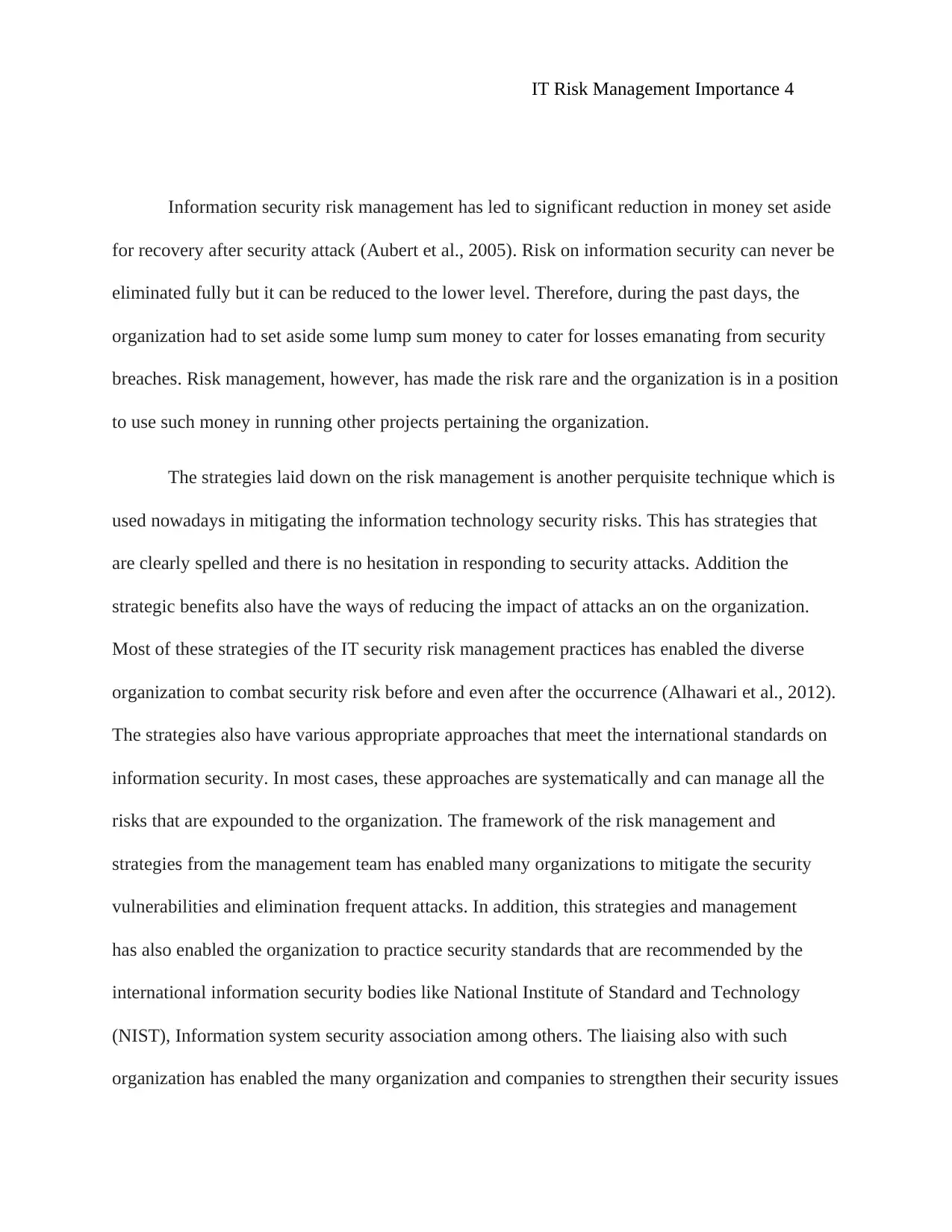
IT Risk Management Importance 4
Information security risk management has led to significant reduction in money set aside
for recovery after security attack (Aubert et al., 2005). Risk on information security can never be
eliminated fully but it can be reduced to the lower level. Therefore, during the past days, the
organization had to set aside some lump sum money to cater for losses emanating from security
breaches. Risk management, however, has made the risk rare and the organization is in a position
to use such money in running other projects pertaining the organization.
The strategies laid down on the risk management is another perquisite technique which is
used nowadays in mitigating the information technology security risks. This has strategies that
are clearly spelled and there is no hesitation in responding to security attacks. Addition the
strategic benefits also have the ways of reducing the impact of attacks an on the organization.
Most of these strategies of the IT security risk management practices has enabled the diverse
organization to combat security risk before and even after the occurrence (Alhawari et al., 2012).
The strategies also have various appropriate approaches that meet the international standards on
information security. In most cases, these approaches are systematically and can manage all the
risks that are expounded to the organization. The framework of the risk management and
strategies from the management team has enabled many organizations to mitigate the security
vulnerabilities and elimination frequent attacks. In addition, this strategies and management
has also enabled the organization to practice security standards that are recommended by the
international information security bodies like National Institute of Standard and Technology
(NIST), Information system security association among others. The liaising also with such
organization has enabled the many organization and companies to strengthen their security issues
Information security risk management has led to significant reduction in money set aside
for recovery after security attack (Aubert et al., 2005). Risk on information security can never be
eliminated fully but it can be reduced to the lower level. Therefore, during the past days, the
organization had to set aside some lump sum money to cater for losses emanating from security
breaches. Risk management, however, has made the risk rare and the organization is in a position
to use such money in running other projects pertaining the organization.
The strategies laid down on the risk management is another perquisite technique which is
used nowadays in mitigating the information technology security risks. This has strategies that
are clearly spelled and there is no hesitation in responding to security attacks. Addition the
strategic benefits also have the ways of reducing the impact of attacks an on the organization.
Most of these strategies of the IT security risk management practices has enabled the diverse
organization to combat security risk before and even after the occurrence (Alhawari et al., 2012).
The strategies also have various appropriate approaches that meet the international standards on
information security. In most cases, these approaches are systematically and can manage all the
risks that are expounded to the organization. The framework of the risk management and
strategies from the management team has enabled many organizations to mitigate the security
vulnerabilities and elimination frequent attacks. In addition, this strategies and management
has also enabled the organization to practice security standards that are recommended by the
international information security bodies like National Institute of Standard and Technology
(NIST), Information system security association among others. The liaising also with such
organization has enabled the many organization and companies to strengthen their security issues
Paraphrase This Document
Need a fresh take? Get an instant paraphrase of this document with our AI Paraphraser
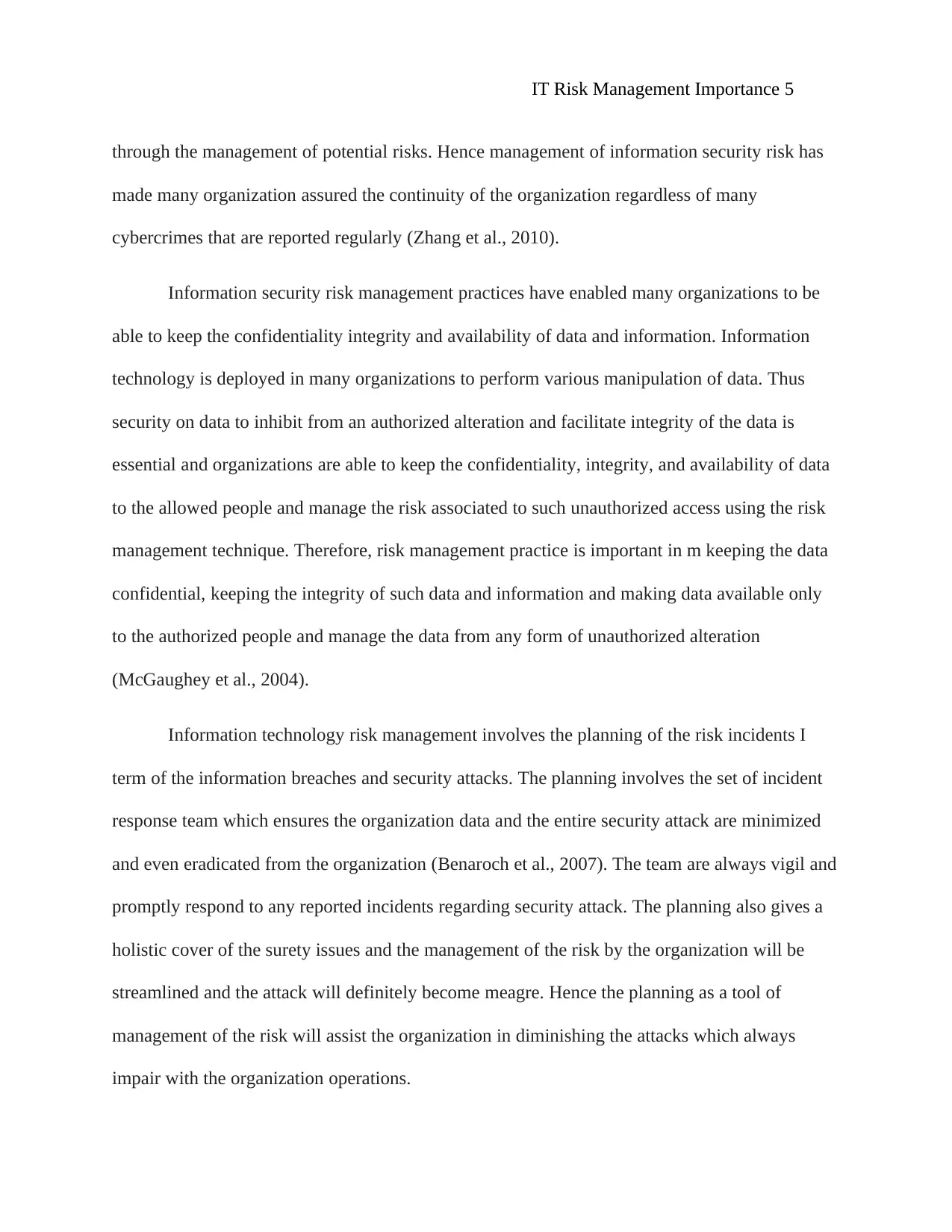
IT Risk Management Importance 5
through the management of potential risks. Hence management of information security risk has
made many organization assured the continuity of the organization regardless of many
cybercrimes that are reported regularly (Zhang et al., 2010).
Information security risk management practices have enabled many organizations to be
able to keep the confidentiality integrity and availability of data and information. Information
technology is deployed in many organizations to perform various manipulation of data. Thus
security on data to inhibit from an authorized alteration and facilitate integrity of the data is
essential and organizations are able to keep the confidentiality, integrity, and availability of data
to the allowed people and manage the risk associated to such unauthorized access using the risk
management technique. Therefore, risk management practice is important in m keeping the data
confidential, keeping the integrity of such data and information and making data available only
to the authorized people and manage the data from any form of unauthorized alteration
(McGaughey et al., 2004).
Information technology risk management involves the planning of the risk incidents I
term of the information breaches and security attacks. The planning involves the set of incident
response team which ensures the organization data and the entire security attack are minimized
and even eradicated from the organization (Benaroch et al., 2007). The team are always vigil and
promptly respond to any reported incidents regarding security attack. The planning also gives a
holistic cover of the surety issues and the management of the risk by the organization will be
streamlined and the attack will definitely become meagre. Hence the planning as a tool of
management of the risk will assist the organization in diminishing the attacks which always
impair with the organization operations.
through the management of potential risks. Hence management of information security risk has
made many organization assured the continuity of the organization regardless of many
cybercrimes that are reported regularly (Zhang et al., 2010).
Information security risk management practices have enabled many organizations to be
able to keep the confidentiality integrity and availability of data and information. Information
technology is deployed in many organizations to perform various manipulation of data. Thus
security on data to inhibit from an authorized alteration and facilitate integrity of the data is
essential and organizations are able to keep the confidentiality, integrity, and availability of data
to the allowed people and manage the risk associated to such unauthorized access using the risk
management technique. Therefore, risk management practice is important in m keeping the data
confidential, keeping the integrity of such data and information and making data available only
to the authorized people and manage the data from any form of unauthorized alteration
(McGaughey et al., 2004).
Information technology risk management involves the planning of the risk incidents I
term of the information breaches and security attacks. The planning involves the set of incident
response team which ensures the organization data and the entire security attack are minimized
and even eradicated from the organization (Benaroch et al., 2007). The team are always vigil and
promptly respond to any reported incidents regarding security attack. The planning also gives a
holistic cover of the surety issues and the management of the risk by the organization will be
streamlined and the attack will definitely become meagre. Hence the planning as a tool of
management of the risk will assist the organization in diminishing the attacks which always
impair with the organization operations.
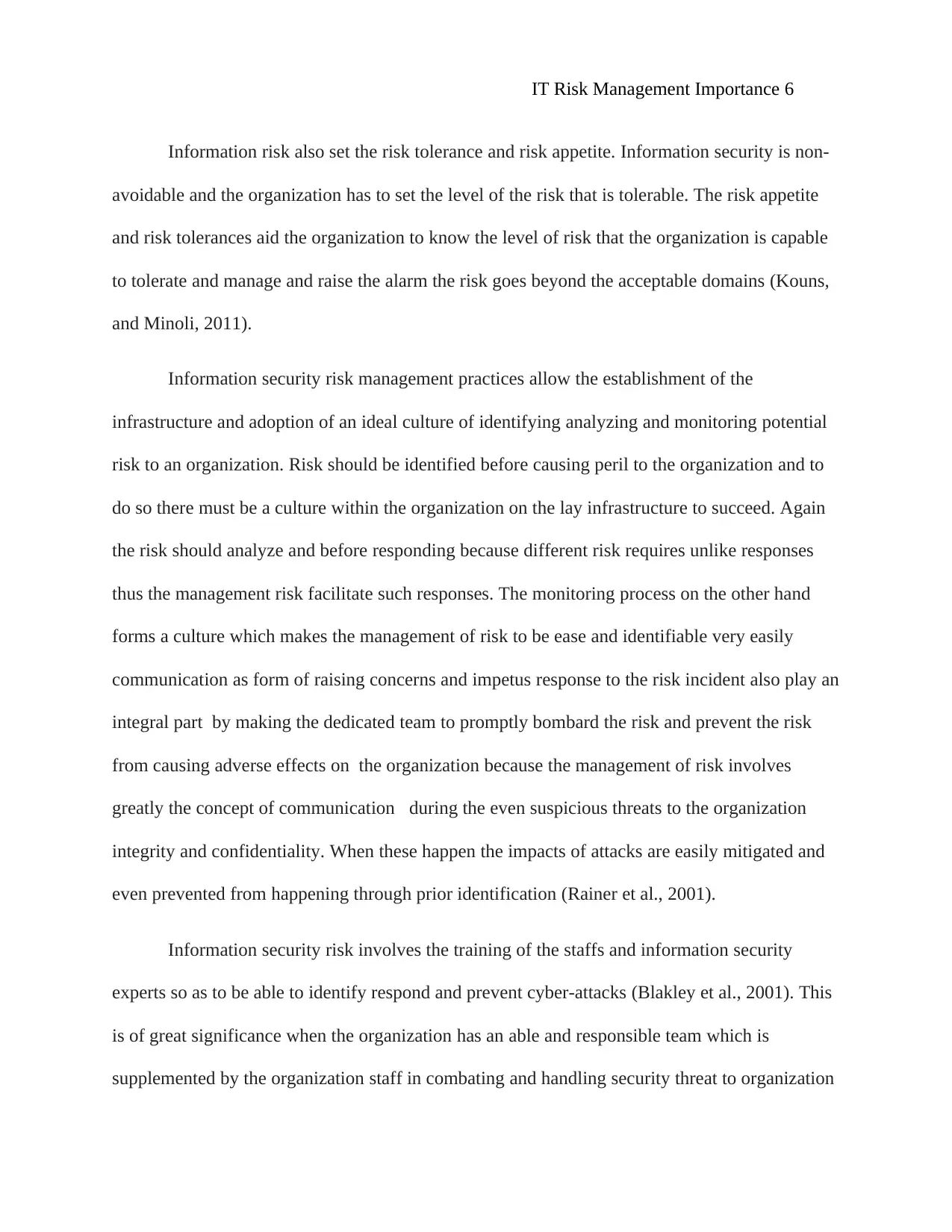
IT Risk Management Importance 6
Information risk also set the risk tolerance and risk appetite. Information security is non-
avoidable and the organization has to set the level of the risk that is tolerable. The risk appetite
and risk tolerances aid the organization to know the level of risk that the organization is capable
to tolerate and manage and raise the alarm the risk goes beyond the acceptable domains (Kouns,
and Minoli, 2011).
Information security risk management practices allow the establishment of the
infrastructure and adoption of an ideal culture of identifying analyzing and monitoring potential
risk to an organization. Risk should be identified before causing peril to the organization and to
do so there must be a culture within the organization on the lay infrastructure to succeed. Again
the risk should analyze and before responding because different risk requires unlike responses
thus the management risk facilitate such responses. The monitoring process on the other hand
forms a culture which makes the management of risk to be ease and identifiable very easily
communication as form of raising concerns and impetus response to the risk incident also play an
integral part by making the dedicated team to promptly bombard the risk and prevent the risk
from causing adverse effects on the organization because the management of risk involves
greatly the concept of communication during the even suspicious threats to the organization
integrity and confidentiality. When these happen the impacts of attacks are easily mitigated and
even prevented from happening through prior identification (Rainer et al., 2001).
Information security risk involves the training of the staffs and information security
experts so as to be able to identify respond and prevent cyber-attacks (Blakley et al., 2001). This
is of great significance when the organization has an able and responsible team which is
supplemented by the organization staff in combating and handling security threat to organization
Information risk also set the risk tolerance and risk appetite. Information security is non-
avoidable and the organization has to set the level of the risk that is tolerable. The risk appetite
and risk tolerances aid the organization to know the level of risk that the organization is capable
to tolerate and manage and raise the alarm the risk goes beyond the acceptable domains (Kouns,
and Minoli, 2011).
Information security risk management practices allow the establishment of the
infrastructure and adoption of an ideal culture of identifying analyzing and monitoring potential
risk to an organization. Risk should be identified before causing peril to the organization and to
do so there must be a culture within the organization on the lay infrastructure to succeed. Again
the risk should analyze and before responding because different risk requires unlike responses
thus the management risk facilitate such responses. The monitoring process on the other hand
forms a culture which makes the management of risk to be ease and identifiable very easily
communication as form of raising concerns and impetus response to the risk incident also play an
integral part by making the dedicated team to promptly bombard the risk and prevent the risk
from causing adverse effects on the organization because the management of risk involves
greatly the concept of communication during the even suspicious threats to the organization
integrity and confidentiality. When these happen the impacts of attacks are easily mitigated and
even prevented from happening through prior identification (Rainer et al., 2001).
Information security risk involves the training of the staffs and information security
experts so as to be able to identify respond and prevent cyber-attacks (Blakley et al., 2001). This
is of great significance when the organization has an able and responsible team which is
supplemented by the organization staff in combating and handling security threat to organization
⊘ This is a preview!⊘
Do you want full access?
Subscribe today to unlock all pages.

Trusted by 1+ million students worldwide
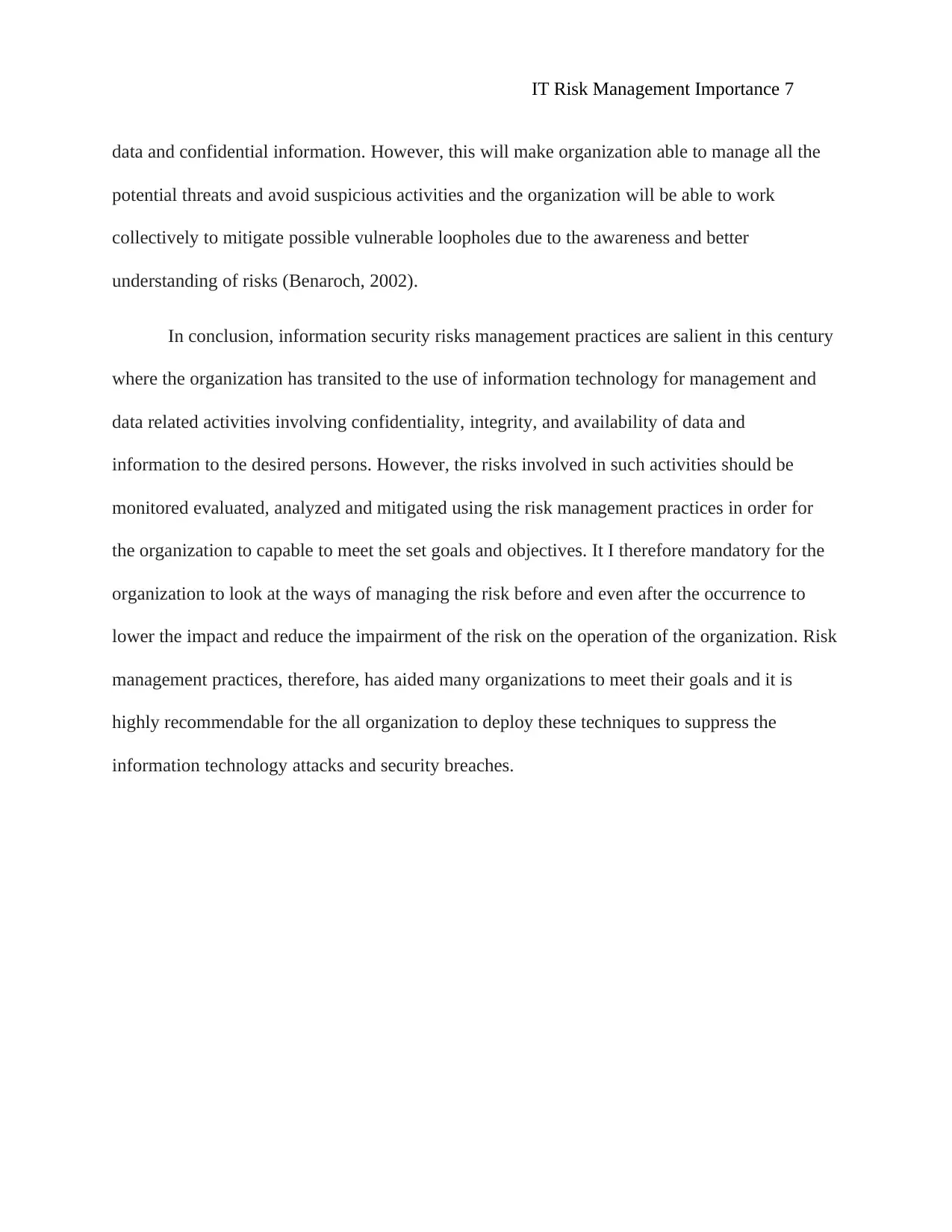
IT Risk Management Importance 7
data and confidential information. However, this will make organization able to manage all the
potential threats and avoid suspicious activities and the organization will be able to work
collectively to mitigate possible vulnerable loopholes due to the awareness and better
understanding of risks (Benaroch, 2002).
In conclusion, information security risks management practices are salient in this century
where the organization has transited to the use of information technology for management and
data related activities involving confidentiality, integrity, and availability of data and
information to the desired persons. However, the risks involved in such activities should be
monitored evaluated, analyzed and mitigated using the risk management practices in order for
the organization to capable to meet the set goals and objectives. It I therefore mandatory for the
organization to look at the ways of managing the risk before and even after the occurrence to
lower the impact and reduce the impairment of the risk on the operation of the organization. Risk
management practices, therefore, has aided many organizations to meet their goals and it is
highly recommendable for the all organization to deploy these techniques to suppress the
information technology attacks and security breaches.
data and confidential information. However, this will make organization able to manage all the
potential threats and avoid suspicious activities and the organization will be able to work
collectively to mitigate possible vulnerable loopholes due to the awareness and better
understanding of risks (Benaroch, 2002).
In conclusion, information security risks management practices are salient in this century
where the organization has transited to the use of information technology for management and
data related activities involving confidentiality, integrity, and availability of data and
information to the desired persons. However, the risks involved in such activities should be
monitored evaluated, analyzed and mitigated using the risk management practices in order for
the organization to capable to meet the set goals and objectives. It I therefore mandatory for the
organization to look at the ways of managing the risk before and even after the occurrence to
lower the impact and reduce the impairment of the risk on the operation of the organization. Risk
management practices, therefore, has aided many organizations to meet their goals and it is
highly recommendable for the all organization to deploy these techniques to suppress the
information technology attacks and security breaches.
Paraphrase This Document
Need a fresh take? Get an instant paraphrase of this document with our AI Paraphraser

IT Risk Management Importance 8
Reference
Alhawari, S., Karadsheh, L., Talet, A.N. and Mansour, E., 2012. Knowledge-based risk
management framework for information technology project. International
Journal of Information Management, 32(1), pp.50-65.
Aubert, B.A., Patry, M. and Rivard, S., 2005. A framework for information technology
outsourcing risk management. ACM SIGMIS Database: the DATABASE
for Advances in Information Systems, 36(4), pp.9-28.
Bandyopadhyay, K., Mykytyn, P.P. and Mykytyn, K., 1999. A framework for integrated risk
management in information technology. Management Decision, 37(5),
pp.437-445.
Benaroch, M., 2002. Managing information technology investment risk: A real options
perspective. Journal of management information systems, 19(2), pp.43-84.
Benaroch, M., Jeffery, M., Kauffman, R.J. and Shah, S., 2007. Option-based risk management: A
field study of sequential information technology investment
decisions. Journal of Management Information Systems, 24(2), pp.103-140.
Benaroch, M., Lichtenstein, Y. and Robinson, K., 2006. Real options in information technology
risk management: An empirical validation of risk-option relationships. MIS
quarterly, pp.827-864.
Reference
Alhawari, S., Karadsheh, L., Talet, A.N. and Mansour, E., 2012. Knowledge-based risk
management framework for information technology project. International
Journal of Information Management, 32(1), pp.50-65.
Aubert, B.A., Patry, M. and Rivard, S., 2005. A framework for information technology
outsourcing risk management. ACM SIGMIS Database: the DATABASE
for Advances in Information Systems, 36(4), pp.9-28.
Bandyopadhyay, K., Mykytyn, P.P. and Mykytyn, K., 1999. A framework for integrated risk
management in information technology. Management Decision, 37(5),
pp.437-445.
Benaroch, M., 2002. Managing information technology investment risk: A real options
perspective. Journal of management information systems, 19(2), pp.43-84.
Benaroch, M., Jeffery, M., Kauffman, R.J. and Shah, S., 2007. Option-based risk management: A
field study of sequential information technology investment
decisions. Journal of Management Information Systems, 24(2), pp.103-140.
Benaroch, M., Lichtenstein, Y. and Robinson, K., 2006. Real options in information technology
risk management: An empirical validation of risk-option relationships. MIS
quarterly, pp.827-864.

IT Risk Management Importance 9
Blakley, B., McDermott, E. and Geer, D., 2001, September. Information security is information
risk management. In Proceedings of the 2001 workshop on New security
paradigms (pp. 97-104). ACM.
Kouns, J. and Minoli, D., 2011. Information technology risk management in enterprise
environments: A review of industry practices and a practical guide to risk
management teams. John Wiley & Sons.
McGaughey Jr, R.E., Snyder, C.A. and Carr, H.H., 2004. Implementing information technology
for competitive advantage: risk management issues. Information &
Management, 26(5), pp.273-280.
Rainer Jr, R.K., Snyder, C.A. and Carr, H.H., 2001. Risk analysis for information
technology. Journal of Management Information Systems, 8(1), pp.129-
147.
Stoneburner, G., Goguen, A.Y. and Feringa, A., 2002. Sp 800-30. Risk management guide for
information technology systems.
Zhang, X., Wuwong, N., Li, H. and Zhang, X., 2010, June. Information security risk
management framework for the cloud computing environments.
In Computer and Information Technology (CIT), 2010 IEEE 10th
International Conference on (pp. 1328-1334). IEEE.
Blakley, B., McDermott, E. and Geer, D., 2001, September. Information security is information
risk management. In Proceedings of the 2001 workshop on New security
paradigms (pp. 97-104). ACM.
Kouns, J. and Minoli, D., 2011. Information technology risk management in enterprise
environments: A review of industry practices and a practical guide to risk
management teams. John Wiley & Sons.
McGaughey Jr, R.E., Snyder, C.A. and Carr, H.H., 2004. Implementing information technology
for competitive advantage: risk management issues. Information &
Management, 26(5), pp.273-280.
Rainer Jr, R.K., Snyder, C.A. and Carr, H.H., 2001. Risk analysis for information
technology. Journal of Management Information Systems, 8(1), pp.129-
147.
Stoneburner, G., Goguen, A.Y. and Feringa, A., 2002. Sp 800-30. Risk management guide for
information technology systems.
Zhang, X., Wuwong, N., Li, H. and Zhang, X., 2010, June. Information security risk
management framework for the cloud computing environments.
In Computer and Information Technology (CIT), 2010 IEEE 10th
International Conference on (pp. 1328-1334). IEEE.
⊘ This is a preview!⊘
Do you want full access?
Subscribe today to unlock all pages.

Trusted by 1+ million students worldwide
1 out of 9
Related Documents
Your All-in-One AI-Powered Toolkit for Academic Success.
+13062052269
info@desklib.com
Available 24*7 on WhatsApp / Email
![[object Object]](/_next/static/media/star-bottom.7253800d.svg)
Unlock your academic potential
Copyright © 2020–2025 A2Z Services. All Rights Reserved. Developed and managed by ZUCOL.





